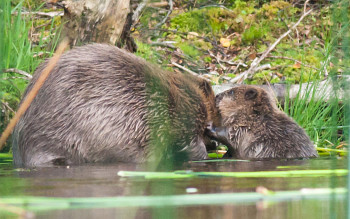
Beaver and kit at Knapdale (Photo: SWT)
A group of European beavers was reintroduced to Knapdale forest near Lochgilphead in 2009, as part of the Scottish Beaver Trial. Since then SNH has been closely monitoring the beavers, and their effects on the environment, in partnership with a number of other independent organisations.
The results of this monitoring will help inform the Scottish Government’s decisions about the future of beavers in Scotland, following the trial, including whether they should be permanently reintroduced. Beavers were hunted to extinction in Scotland in the 16th century.
The report summarises the results of monitoring work carried out on the beavers themselves over the first two years of the trial, from their release in May 2009 until June 2011. It also reports on the use of the site by otters. The work was carried out by the Wildlife Conservation Unit at the University of Oxford (WildCRU) in partnership with SNH staff, largely based on observations collected by Scottish Beaver Trial field staff.
Three beavers died in the first year of the trial and a further three disappeared from the trial site. In the second year there was one disappearance and no deaths. All the beavers captured for routine health checks were in good body condition. Evidence including gnawed or felled trees, tracks, beaver dams or lodges, gave a good overview of the areas used by beavers and their activities on land. Beavers have been described by ecologists as “natural woodland managers” as they go about their daily business of building dams and expanding their habitat, but critics of the trial, which include anglers, have raised concern about the environmental impact.
Earlier this month three beaver kits were spotting by project workers. It is thought that all three were born on Dubh Loch, to the same beaver family. It is the largest number to be born in any year since the Trial started.
Roisin Campbell-Palmer, a manager with the beaver trial, said of the new arrivals: “This family has bred every year since release, but only giving birth to one kit each year. Unfortunately, last year’s kit didn’t survive, so seeing three newly emerged kits is really great news for the trial, because it’s a boost to the beaver population.”
There are now 15 beavers at Knapdale, including six who were born at the trial site. Future monitoring is to be carried out to include measures to identify where individual beavers are living and how much time the beavers spend in the water compared with on land.
Martin Gaywood, who leads the independent scientific monitoring of the trial for SNH said: “As part of the trial we are monitoring both the effects of beavers on their environment and seeking to gain a better understanding of their ecology in a Scottish context. These annual reports are vital to the trial, because they show us how beavers are getting on at Knapdale. At the end of the five year trial the results of the monitoring work will give the Scottish Government the information they need to decide whether beavers should be permanently reintroduced to Scotland.”
Dr Lauren Harrington, from WildCRU added: “In the reports that cover the next three years of the trial we hope to assess the success of the trial population and to be able to make more comparisons with the ecology of reintroduced beavers in other European countries.”
Commenting on the sighting of the new beaver kits earlier this month, Scottish Environment Minister Stewart Stevenson, said: “I am pleased to see the beaver trial population thriving with the arrival of three new kits – I look forward to watching their progress in future.”
The Scottish Beaver Trial site at Barnluasgan can be visited by the general public and there is an attractive walk thorugh the woods and alongside some of the lochs, the beavers however are elusive and you are more likely to see evidence of their existence although some visitors have had their patience rewarded with a sighting. The Knapdale area provides a varied range of coastal and country walks with the rich array of pre-historic remains at Kilmartin Glen nearby.
